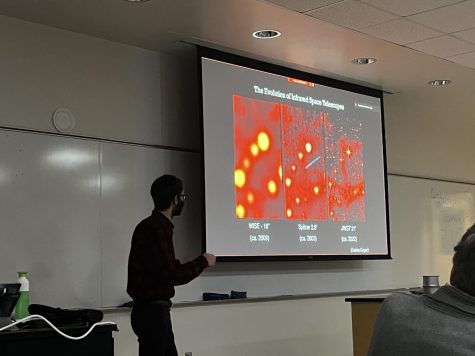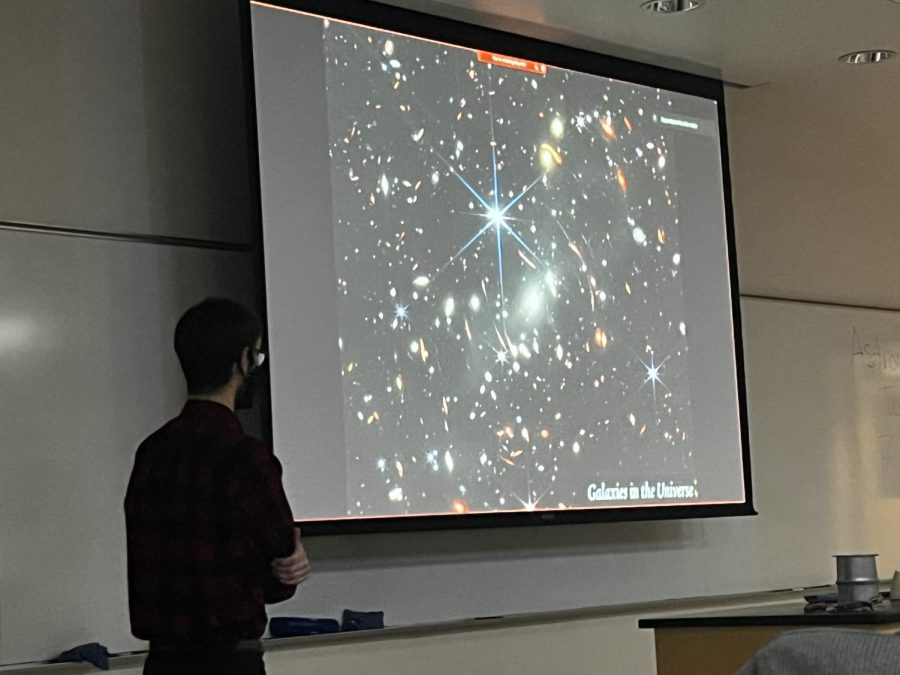Discovering new galaxies every day
Professor Michael Maseda of the University of Wisconsin-Madison, explaining how the telescope takes photos of galaxies that have never been visible on telescope cameras before.
December 4, 2022
The JWST otherwise known as the James Webb telescope, launched in 2022, is the first ever telescope that is the newest and most effective way to take infrared photos from space. This telescope was launched into space as a one shot deal, being placed 1 million kilometers away from earth, and had to unfold all on its own. Joining Whitewater from University of Wisconsin-Madison, Professor Michael Maseda came to explain how the telescope works and why it is so important to the astronomy community. With the telescope being 21 feet in length, taking over 25 years to create, and being made of over 100 mirrors, this telescope is a huge help to finding out information on space. Because this telescope was created by physicists from Canada, Europe, and the United States, it had the best in the field helping to create something that won’t only last in space, but will also be able to capture impressive photos.

(Libby Nabhan )
The JWST sits in space, and takes infrared photos; this means that it shows the heat of objects after sitting for an extended period of time. The previous telescope, the Hubble, was closer to the earth, sitting at around 570km away from the earth, while the JWST is roughly 1 million kilometers away, therefore this new telescope has the ability to take shots that don’t have the earth in them, giving them a better view of the galaxies. The main goal of this telescope is to see the galaxies that haven’t been able to be seen. Because of the vast area of space, there is no way of knowing how many galaxies there are, which means that having this available in space to take photos of the galaxies that we haven’t in the past, there is a better chance of discovering something that can help to understand space more.
“This telescope can detect a bumblebee on the surface of the moon; which shows the vast variety of JWST,” said Professor Michael Maseda of the University of Wisconsin-Madison, on the vast contrast that this telescope has. Overall this means that the caliber of this camera on the telescope is using the infrared waves to take a photo of the light waves that are emitted by the stars and galaxies. And the ability to see a bumblebee’s heat on the moon means that it can see heat that is so small that would’ve been overlooked in the original telescope, the Hubble. Since the space has a general temperature of true 0, the camera being able to see that small amount of heat, there is a chance that it will be able to pick up the heat waves from galaxies. And also, not only picking up the galaxy’s heat, but the star heat; which is important because the discovery of these stars and galaxies will help to explain more and more about space, as much is unknown. Throughout his presentation, Maseda explained the background of how light waves work and how the telescope takes photos, and how that will help with research in the future.
“I think it was a great presentation that gave information to the audience in a comprehensive way while still providing complex information,” said Alex Phipps, a freshman physics major. This presentation not only helped for the physics community, but within the college because it shows many details that differed from the other known information. Before this came out, we didn’t know that some stars were born in pairs, and the images of stars being born and dying is showing differently than before. This complex information helps because individuals that helped create this have the opportunity to take photos and make discoveries; and people such as the professor who are simply in the physics departments have the ability to utilize this telescope as well. Overall, the telescope is creating more and more resources to find out information about space, which will lead to more questions being asked and then being able to answer them.
The next telescope presentation on JWST will be held in Upham on February 3rd at 7:30pm. And to learn more about events like this visit: https://www.uww.edu/cls/departments/physics/observatory













